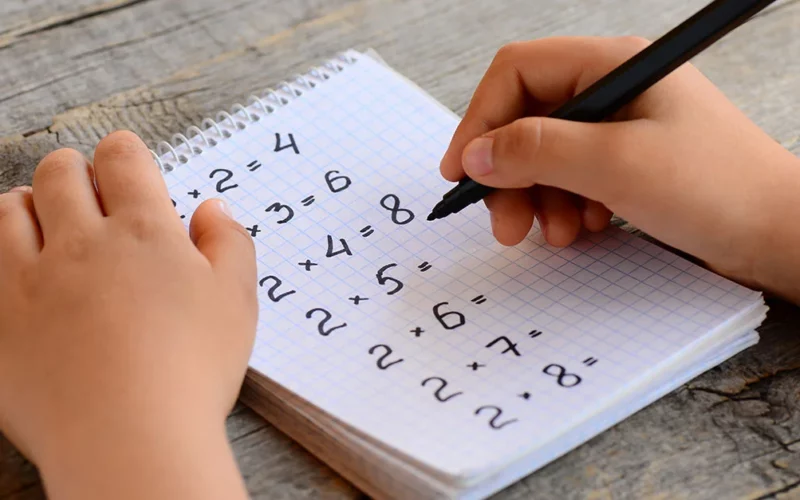As schools nationwide contend with declining math scores, some districts are dedicating more time to the practice of foundational skills.
It’s the end of math class at Forest Hills Elementary School in Sidman, Pennsylvania, and after a short break, fourth-grade teacher Dawn McCall’s students are getting down to business—with an additional 20 minutes of math work.
McCall’s students know the routine: They pair off with a partner—usually a higher-performing student and a lower-performing one—and work through short sets of problems together that target weak or missing skills, like multi-digit subtraction or multiplication. One student solves the problem while describing their thinking aloud; the other student offers support and highlights mistakes. Then they switch roles.
This is Spring Math, a short and intensive math intervention that McCall’s school is implementing for all students, regardless of their achievement levels. The targeted daily practice is designed to strengthen foundational skills, and it’s rapidly putting grade-level math mastery within reach for a lot more students, according to McCall.
“To succeed at fractions and decimals, you have to know your multiplication and division facts,” McCall said. “If you know those multiplication and division facts, things like reducing fractions is going to be a lot easier. It’s that little extra bit of practice every day.”
Start of newsletter promotion.
Since Forest Hills Elementary began implementing the math intervention at the beginning of 2018—slowly adding a few grades at a time, beginning with fourth through sixth grade—student test scores for some participating groups have steadily improved, according to assistant superintendent Dr. Rob Dill.
In 2022, 56 percent of fourth graders at the school scored proficient or advanced on the Pennsylvania System of School Assessment state test; by fifth grade, 76 percent of those same students scored proficient or above.
Meanwhile, math achievement across the nation is headed in the opposite direction. Only 36 percent of fourth graders scored proficient in math on the 2022 National Assessment of Educational Progress (NAEP) after a historic five-point drop following pandemic school closures.
For the decade before that, scores had hovered around only 40 percent proficiency. Eighth-grade achievement dropped even more—down eight points from 2019, with only 26 percent of students scoring proficient; 40 percent scored below basic.
Now, a growing number of researchers, school leaders, and educators are calling attention to research-based solutions to combat slippage in math, including the crucial role that adequate practice time plays in student performance.
“They are considered dirty words, but drill and practice, and explicit instruction on how to procedurally solve math problems, are evidence-based strategies that work,” said SUNY University at Albany math researcher Ben Solomon.
There’s often a misconception that rote math practice is dull and uninteresting, but “think about how adults thought phonics was boring, but kids actually feel awesome when they can be successful at learning to read,” said University of Winnipeg professor of mathematics Anna Stokke. “It’s the same with math. Teaching foundational math skills does not need to be mindless and boring. Adults who have already mastered a topic don’t view things with the same sense of excitement that kids do. Kids get excited about math when they feel successful, regardless of the topic.”
The Fluency Question
A key missing ingredient in higher math achievement is math fluency, especially in the basic operations of addition, subtraction, multiplication, and division. Research shows that fluency in these foundational skills is critical to math performance and achievement, but experts and educators say there’s a disconnect between how much practice students need to achieve fluency—especially students who struggle with math—and how much they often get in classrooms.
The National Mathematics Advisory Panel includes the importance of practice in basic operations among its top findings and recommendations—”Computational proficiency with whole number operations is dependent on sufficient and appropriate practice to develop automatic recall,” the authors write—yet schools and teachers say that, for a variety of reasons, students aren’t getting enough practice to solidify foundational concepts.
Lack of procedural skill often keeps students from ever reaching the creative, open-ended side of math. “We need to give them the basic tools and then play with them in many different ways so they can explore the beauty of math,” said cognitive scientist Daniel Ansari, professor and Canada research chair at the University of Western Ontario in London, Ontario. “But first they need the basic building blocks.”
Obstacles to practice time
Math practice gets short changed for a constellation of reasons—an overstuffed curriculum and the drive to cover an overwhelming number of standards; test-prep pressure; and instructional philosophies that consider repetitive practice, sometimes negatively referred to as “rote” or “drill and kill,” to be uniformly harmful and to be avoided at all costs.
In classrooms, teachers say there’s just not enough time for extra practice. Pressured to cover every state standard with equal emphasis, they often can’t spend extra time on fundamentals like memorizing multiplication tables, or even on the standards themselves.
“It’s a huge problem,” said Sarah Powell, associate professor at the University of Texas at Austin, who researches math instruction and trains teachers. Some districts go so far as to put out a calendar dictating what every teacher should be working on every week of the year—regardless of how far along (or behind) their students are in the curriculum, Powell noted.
“We have trapped ourselves with having so many expectations; at each grade level there are these standards, and you are supposed to cover these 30 things and not let anything go,” she said.





